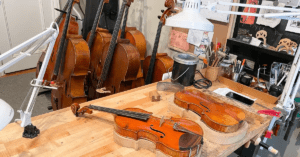
All You Need to Know Before Buying a Saute Pan
As it serves several purposes in the kitchen, a pan is an essential tool. And although it’s possible to use a sauté pan instead of a skillet, the latter is often seen in kitchens. Although a skillet is more conventional, sauté pans or skillets can be used for frying and other everyday cooking.
The First Sauté Pans
The term “saute,” which refers to cooking food in oil, is where the term “saute pan” comes from. For those etymologists, sauté is the male past simple or past participle form of the French verb Sauter (to leap), which means “jumped.” The name “sauté” stems from how food “jumps” about in the pan while it cooks. However, just because the term has a French origin does not mean that it is limited to French cooking. It has rapidly become a standard preparation method in homes throughout the world.
Gains From Using it
These pans are better suited to several cooking methods than a skillet because of their distinctive form.
Braising
Braising, which may produce exceptionally soft and flavorful meat, is best done in sauté pans. When used for braising, these pans are superior to a skillet.
When braising, the first step is to sear or sauté the meat over high heat to develop a crust. The meal is then covered and stewed in a liquid such as broth, stock, or wine until it is soft and has absorbed the flavours of the liquid, often for several hours. This method is superior to using a pan if you want to make beef ribs or chicken thighs that easily pull apart while eating.
Make sure the handles are also oven-safe before purchasing these pans for the oven, and stainless steel and cast iron are good options. Using an oven-safe pan, you may transfer the dish to finish braising. Meat that has been seared and then braised retains its moisture and becomes very soft. Also, instead of finishing your food in the oven, you may use this pan as a little dutch oven by leaving it on the stove over low heat.
Frying
It is superior to a skillet for frying food in oil due to its depth and volume. While these pans may be used for deep frying in small quantities, their true strength is in shallow frying. And thanks to the pan’s straight edges and tight-fitting top, you won’t have to worry about oil splattering all over the stove or you.
Searing
Many little objects or one oversized item (like a steak) may be seared at once in it (like chicken thighs). Stainless steel is excellent for searing because of how evenly it conducts heat. And when the sear is done, you may deglaze the pan with an astringent, such as red wine, to release the delectable parts that have adhered to the pan and prepare the sauce coup de grâce.
Criteria for Good Sauté Pans
You may get sauté pans in a wide range of materials, from stainless steel to cast-iron to ceramic nonstick to hard-anodised nonstick. And when choosing one, you should prioritise dependability and usefulness.
Stainless steel, aluminium, and stainless steel again make up the tri-ply structure of particular sauté pans. Aluminium is an effective heat conductor, while stainless steel is good at retaining and redistributing heat. Thus, the two materials work well together in this multi-ply construction. While the copper core of individual pans is worth the extra cost, some pans don’t have one. Also, the stainless steel pan is made with better 5-ply construction, which combines aluminium and stainless steel, rather than the more common 3-ply design. Maximum conductivity, heat retention, and even heat distribution are all achieved by this 5-ply stainless steel system.

